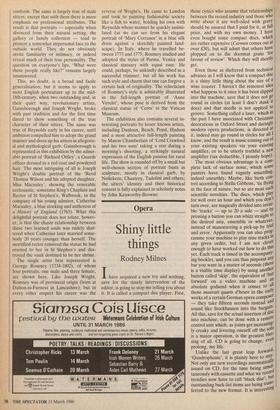Exhibitions
The British race: a View of Portraiture 1625— 1850 (Colnaghi until 29 March)
Conforming to type
David Wakefield
Attitudes to portraiture and collecting portraits have undergone a quiet revolu- tion in the last decade or so. Portraits of unwanted ancestors, often grimy and tat- tered, were dispatched to the salerooms in large quantities by their unsentimental heirs, usually glad to raise a little cash and clear some extra space for redecoration.
London clubs have shown still less scruple in 'clearing out' the decent, unregarded portraits on their walls. From the buyer's point of view it was still considered slightly non-U to acquire portraits of other peo- ple's ancestors — a lingering Victorian prejudice -- and to fill one's house with them. Portraits, however, like the men and women they represent, quickly come to life again in new surroundings, provided they are loved and cherished, This discovery has led to a new appreciation of the art of portraiture, exemplified in the current exhibition at Colnaghi's. The artistic level of the exhibits is, it must be admitted, variable; but the emphasis here is sensibly placed as much on the historical as on the artistic factors which determined the artist's choice of sitters, their dress, pose and other attributes. In a fascinating intro- ductory essay John Martin Robinson shows how the cult of ancestors, real and bogus, has played a long and honourable role in the history of British collecting and has helped to maintain a respectable standard of realistic painting to this day.
Portraits Still present problems of identi- ty to the average spectator. Each artist presents a certain stereotype, correspond- ing to the ideal of fashion and feminine beauty of the day: buxom and scantily clad with Lely (Mary West'), cool and poised with Kneller ('Elizabeth Pelham'), elegant- ly statuesque with Romney (`Anne Verelst'), and the 'ripe and wholesome English beauty' of Hoppner's portrait of Lady Almeria Carpenter'. Each of these portraits embodies a certain type to which, it seems, most women of position wished to conform. The same is largely true of male sitters, except that with them there is more emphasis on professional attributes. The result is that portraits — especially when divorced from their natural setting, the gallery or family collection — tend to present a somewhat impersonal face to the outside world. They do not obviously invite familiarity or intimacy, or indeed reveal much of their true personality. The question on everyone's lips, 'What were these people really like?' remains largely unanswered.
This, no doubt, is a broad and facile generalisation; but it seems to apply to most English portraiture up to the mid- 18th-century, when two outstanding and, in their quiet way, revolutionary artists, Gainsborough and Joseph Wright, broke with past tradition and for the first time dared to show something of the true character of their sitters. The same was true of Reynolds early in his career, until ambition compelled him to adopt the grand manner and dress up his sitters in allegoric- al and mythological garb. Gainsborough is represented in this exhibition by the admir- able portrait of 'Richard Ottley', a Guards officer dressed in a red coat and powdered hair. The most intriguing of all is Joseph Wright's double portrait of the 'Revd Thomas Wilson and his adopted daughter, Miss Macauley', showing the venerable ecclesiastic, sometime King's Chaplain and Rector of St Stephen's, Walbrook, in the company of his young admirer, Catherine Macauley, a blue stocking and authoress of a History of England (1763). What this delightful portrait does not relate, howev- er, is that the chaste relationship between these two learned souls was rudely shat- tered when Catherine later married some- body 20 years younger than herself. The mortified rector removed the statue he had erected to her in St Stephen's and des- troyed the vault destined to be her shrine.
The single artist best represented is George Romney (1734-1802), of whom four portraits, one male and three female, are shown here. Like Joseph Wright, Romney was of provincial origin (born at Dalton-in-Furness in Lancashire), but in every other respect his career was the reverse of Wright's. He came to London and took to painting fashionable society like a fish to water, holding his own with Reynolds whose manner he quickly assimi- lated (as We can see from his elegant portrait of 'Mary Corrance' in a blue silk dress against a sketchily painted land- scape). In Italy, where he travelled be- tween 1773 and 1775, Romney studied and adopted the styles of Parma, Venice and classical statuary with equal ease. He could, perhaps, be unkindly described as a successful trimmer, but all his work has such style and charm that one can forgive a certain lack of originality. The eclecticism of Romney's style is admirably illustrated in the full-length portrait of 'Anne Verelst', whose pose is derived from the classical statue of 'Ceres' in the Vatican Museum.
The exhibition also contains several in- teresting portraits by lesser known artists, including Danloux, Beach, Pond, Hudson and a most attractive full-length painting by Mason Chamberlain of 'Lord Crawford and his two sons' taking a rest during a morning's shooting, a strikingly natural expression of the English passion for rural life. The show is rounded off by a small but well-chosen section of portrait busts in sculpture, mostly in classical garb, by Nollekens, Chantrey, Tadolini and others; the sitters' identity and their historical context is fully explained in scholarly notes by John Kenworthy-Browne.



















































 Previous page
Previous page